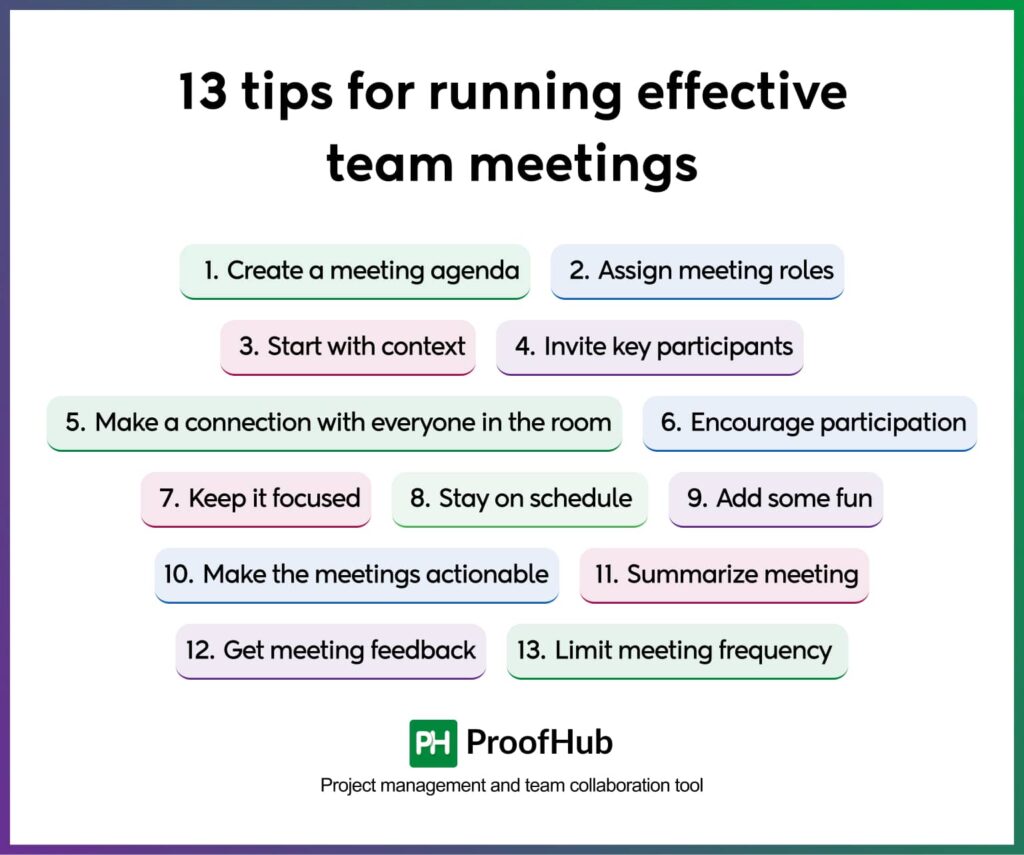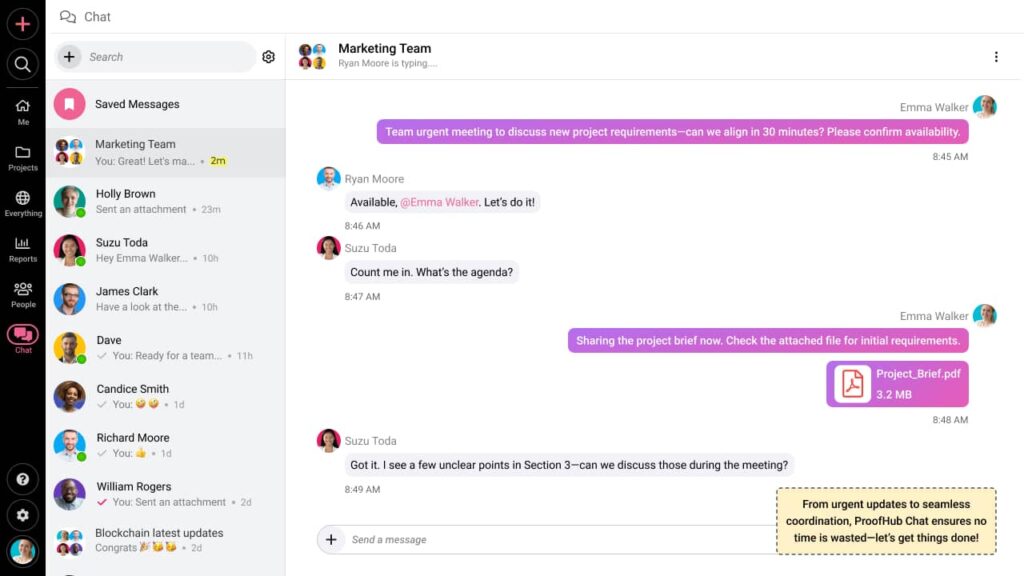Introduction
“Is this meeting really necessary?” “Why are we even having this meeting?” or “What a waste of time!”
These are some common phrases that you have likely heard or thought of yourself in the context of meetings. While team meetings play a vital role in promoting collaboration, having too many can quickly hinder focus and productivity.
To put it in numbers, around 83% of people spend one-third of their workweek in meetings, costing businesses 24 billion hours annually. This highlights the pressing need to carry out purposeful and effective team meetings.
To address this, here are 13 key tips to help you conduct more efficient meetings, along with the strategies to rethink and eliminate unnecessary ones.
What is the purpose of team meetings?
What are the reasons to have team meetings when they are so frustrating? While meetings have developed a detrimental reputation over time, they remain an integral part of the business environment.
From promoting open communication to building team cohesion, meetings allow team members to collaborate, sync up, and stay on the same page.
No matter how inefficient or time-consuming they may seem, completely cutting them off is not a practical solution to avoid overwhelm. Here are some compelling reasons not to avoid them:
- Brainstorming and discussion: Meetings allow creative thinkers to share diverse perspectives and generate ideas – something that would be difficult to achieve by a single person alone.
- Team building: Interaction through meetings helps team members develop key interpersonal and organizational skills, instilling a sense of togetherness and commitment.
- Share information: Well-structured team meetings ensure everyone receives the same information, ensuring no confusion and successful alignment.
- Providing feedback: Meetings allow team members to provide necessary feedback, enabling timely and necessary adjustments.
- Facilitating collaboration: Team meetings bring everyone together to share expertise, discuss challenges, and collaborate in real-time.
- Enhancing communication: Regular meetings ensure open and transparent communication, driving alignment across the team.
- Problem-solving: Bringing together different perspectives helps the team approach a problem from multiple angles, brainstorming more effective solutions.
- Finding solutions: Meetings allow team members to carefully analyze options and arrive at the optimal solution through thoughtful discussions.
- Planning and coordination: Meetings provide a dedicated space for strategic thinking and planning, ensuring everyone is moving in alignment towards strategic goals.
- Decision making: Team meetings are critical when decisions require input from multiple team members, ensuring these are well-informed and thought.
13 tips for running effective team meetings
Meetings, often seen as tedious and unproductive, in fact, form the essential business component to drive collaboration. However, if not structured properly, these can quickly turn into a time sink that can throw off your productivity and efficiency – before you even realize it.
Here are some practical tips to conduct effective team meetings that don’t end up becoming a big waste of time.

1. Create a meeting agenda
Developing a team agenda is an essential factor in introducing clarity and transparency in your meetings. It provides a clear outline of the necessary points to be addressed and covered, ensuring everyone is aligned on objectives. Because with a clear agenda in hand, team members come prepared and stay focused. They know the direction to move in their discussions for productive outcomes, eliminating any vagueness and ambiguity that could derail the discussion. By detailing action items in advance, you ensure that everyone is on the same page.
Key elements to include in your agenda:
- Meeting details such as date, time, and duration
- Meeting location or platform
- Meeting purpose and goals
- List of attendees
- Topics to discuss and prioritize
- Anticipated outcomes
- Relevant pre-work materials
Be sure to send the agenda at least one or two days in advance, allowing team members ample time to review and prepare.
2. Assign meeting roles
One practical way to conduct effective team meetings is by assigning a designated role to each member. When team members are aware of their responsibilities, they tend to stay focused and avoid confusion. Also, switching roles can bring out diverse opinions and perspectives, facilitating more dynamic discussions. This clear delegation of responsibilities encourages active and mindful team participation.
For example, several roles that can be assigned to team members are:
- Facilitator
- Note taker
- Timekeeper
- Presenter
- Contributors
- Decision maker
And more.
3. Start with context
Every called meeting should provide participants with a clear agenda and purpose from the outset. Avoid leaving them speculating about its necessity and forming misinformed opinions. By communicating the meeting’s purpose beforehand, you can lead meaningful discussions, save valuable time, and promote inclusivity. This shared clarity prevents teams from falling into an unproductive cycle of baseless discussions.
For example, providing clear context could look like this:
“In today’s meeting, we’ll discuss the Q4 marketing plan. Last quarter’s efforts fell short of our lead generation goals by 15%, so we’ll brainstorm strategies to improve our outreach.”
4. Invite key participants
When it comes to inviting attendees to meetings, more is not always the merrier. Avoid sending meeting invitations to everyone in your team to fill seats, sit idle, or for their mere presence. Doing this not only wastes their time but drains their productivity and focus for no good use. Trust me, people resent it when their time gets wasted for nothing, leaving them frustrated and disengaged.
To avoid this mess, evaluate the ideal number of attendees based on meeting context, purpose, objectives, relevance, and valuable contributions they can make. Some examples of where you should adjust your approach include:
- Team building activities – Invite the entire team to promote unity and collaboration
- Strategic discussions: Limit to key decision-makers and stakeholders to ensure focused, actionable outcomes.
- Project updates: Include only those directly involved to streamline communication and avoid redundancies.
5. Make a connection with everyone in the room

Meetings often start with a manager or team leader reading the agenda and proceeding without context, leaving team members feeling disconnected from the discussion. But by interacting and connecting with everyone in the room, you set a collaborative tone. Team members feel encouraged to push their minds to brainstorm, contribute without hesitation, and participate actively. Small but meaningful gestures – like learning attendees’ roles, greeting each person individually (even a simple hello), and acknowledging their contributions – can promote collaboration, engagement, and inclusivity during the meetings, improving team dynamics in the long run.
To take it a step further, using tools like ProofHub before, during or after meetings – can speed up communication effectively. Whether it’s a quick chat, question (use @mention), sharing files or sending digital assets directly to team members, these features ensure everyone stays aligned and informed.
6. Encourage participation
Meetings are most effective when a group of people come together to bring ideas, insights, and solutions to the table. However, when these individuals start to feel hesitant to speak up, nothing substantial comes out of the process. As a leader, it’s your responsibility to create an environment that encourages engagement. Make team meetings a safe space where contributions are acknowledged and respectful communication is prioritized – free from criticism, mocking or embarrassing remarks.
Some encouraging statements that can promote participation are:
- “We’d love to hear your thoughts.”
- “Let’s discuss this together.”
- “Your input is valuable to us.”
- “Feel free to share your perspective.”
Or you can also ask open-ended questions to draw people into the discussion:
- “What are your thoughts on this approach?”
- “Does anyone have alternative ideas?”
- “How do you think we can improve this process?”
- “What challenges do you foresee with this plan?”
This will encourage them to participate in the discussions and be involved meaningfully.
7. Keep it focused
Meetings can quickly turn into a cross-talk if not structured and managed properly. Whether in the office or remote, distractions can easily arise, pulling participants away from the task at hand. On the other hand, focused discussions keep everyone engaged and on track. By sticking to the topic, engaging with the right people, and staying committed to the schedule, you can maintain focus and address key issues effectively and promptly.
8. Stay on schedule
Meetings are necessary for promoting collaboration and streamlining workflow. To be effective, they should be time-bound and focused on accomplishing tasks rather than becoming tasks in themselves. Punctuality is key – start meetings on time and ensure they end as scheduled. In fact, one of our recent polls data reveals that 40% of people believe the daily stand-up style works best for remote teams, highlighting the importance of short, focused meetings. To maximize meeting impact even further, avoid stretching beyond the allocated time unless absolutely necessary. Also, keep track of time and gently intervene if it starts to stretch into a long-drawn-out session. This approach helps team members prioritize key discussions, avoid unnecessary tangents, and stick to the agenda for better focus and efficiency.
9. Add some fun
Meetings and fun? Yes, that’s possible. You can add some fun and excitement to your meetings by kicking off with a lighthearted anecdote, doing some fun team meeting activities, or creating a comfortable space to bring something extraordinary out of boring meetings. You can also give others the liberty to share their success story or sponsor some engaging material to break up the monotony. These team meeting activities not only refresh the team but also keep their energy levels high and engage them to the fullest, making everyone look forward to future meetings.
10. Make the meetings actionable
While conducting a meeting, do not let any ambiguity linger on. Be clear and precise in your communication, and document key points to eliminate uncertainty. Avoid passing on vague statements, and be specific in your instructions.
For example – “We will kick off this project by Friday, and John will have the marketing report ready by tomorrow.”
Clarify expectations and ask direct questions to ensure accountability.
For example –
“What are the tasks to be done next week?”
“What new strategies did you learn from this meeting?”
“Who will take charge of this task?”
Ending your meeting with such simple questions ensures that responsibilities and expectations are clearly understood, leaving no room for confusion or misunderstandings.
11. Summarize meeting
Your meeting wrapped up – now what? Your work doesn’t stop there! Always prioritize sending meeting notes to all the attendees and concerned stakeholders to keep everyone in the loop. Put together all the key takeaways, discussion points, action items, unresolved issues, assigned tasks, responsibilities, deadlines, and decisions taken. These summaries act as a reliable reference to get back to in future, ensuring clarity, alignment, and accountability with the meeting’s objectives.
12. Get meeting feedback
After your meeting is over and summaries are distributed, ask for feedback to improve the effectiveness of your team meetings. It helps identify what’s working fine, areas that need improvement, and any uncovered gaps, ensuring meetings stay relevant and productive over time. Whether you take feedback at the end of the meetings or schedule a moment for later, encourage participants to be honest and candid about their thoughts and opinions without any fear of judgment. Finally, pinpoint the challenges raised, prioritize actionable items, and ensure every issue is addressed and resolved.
13. Limit meeting frequency
Last but not least, it is essential to keep in mind that excessive meeting count is not always efficient. It is a territory where quality outweighs quantity. To limit the frequency of meetings, consider these actionable steps.
- Identify the necessity and the duration of recurring meetings
- Determine whether these meetings are truly necessary
- Explore if the topics can be addressed asynchronously
Remember, fewer meetings create more room for focused team interactions, promoting more impactful discussions, higher-quality contributions, and uninterrupted productive time.
Before you schedule: Decide whether a meeting is needed or not
Time is valuable—both yours and your team’s. And being a leader, it becomes your responsibility to ensure it doesn’t go to waste. Considering meeting overload tops the list of being a productivity drainer, it is essential to rethink the need to schedule a meeting for every issue.
Bouncing from one meeting to the next makes the team feel unfocused, confused, and drained, questioning the necessity and value of the meeting. That is why it’s crucial to evaluate whether a meeting is truly necessary.
To evaluate meeting necessity:
- Start by determining if the meeting has a clear and solid objective.
- Evaluate any alternative that could serve the purpose without eating into productivity hours.
- Consider the return on time invested in the meeting.
- Understand the impact of meetings on a team’s workload.
- Access meetings’ urgency and alignment with priorities.
Doing so, you:
- Respect your team’s time and energy.
- Keep annoyance away from your team.
- Free up their time for focused and meaningful work.
- Foster a culture of purpose and efficiency.
The above tips can help you avoid scheduling unnecessary meetings, ensuring the ones you hold are intentional and productive.
FAQs
How do you run an effective team meeting remotely?
To run an effective team meeting remotely, make sure to
- Construct a clear meeting agenda for all participants.
- Next, the crucial factor is to choose the right platform that is suitable for your team’s needs. Make sure to test the technology before the meeting starts.
- Keep the meetings purposeful and focused, and stick to the schedule to respect everyone’s time.
How can I encourage team participation during meetings?
There are multiple ways you can encourage your team to participate during meetings:
- Create a safe environment for the team to feel confident contributing.
- Fill them in on clear objectives and agenda before the meeting commences for better understanding.
- Do not interrupt and listen actively when others are speaking; wait for your turn.
- Embrace patience during the moments of silence.
- Normalize appreciating and highlighting valuable contributions.
What are some common mistakes to avoid in team meetings?
Some common mistakes you should not make in team meetings are:
- Bashing or mocking any idea or suggestion.
- Inviting individuals with little to no relevance to the meeting.
- Overrunning the scheduled time and disrespecting participants’ schedules.
- Making anyone feel left out of the discussion.
- Ignoring non-verbal cues of participants that might signal confusion, hesitation, or discomfort.

